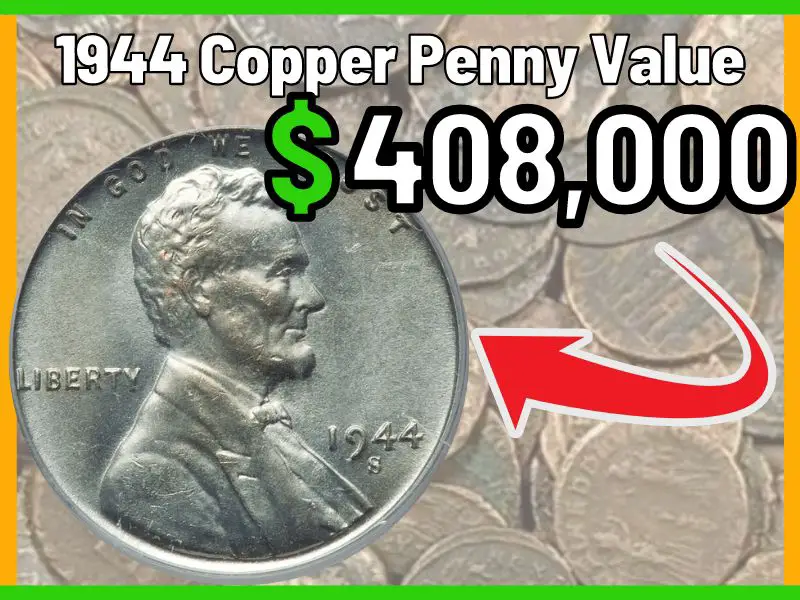
The no mint mark 1944 copper penny is valued at $4.70 in brilliant uncirculated condition graded MS 63. It is worth $0.05 in fine condition.
The 1944 copper penny with the D mark is worth $4.52 in brilliant uncirculated condition and $0.11 in very fine condition. The S marked 1944 copper penny is valued at $0.11 in fine condition and $4.52 in brilliant uncirculated condition with a grade of MS 63.
As you can see the 1944 no mint mark copper penny, the D and S marks aren’t worth much.
Where the real deal comes in for the 1944 copper penny is in the error types and variations some of which can bring a premium price when graded highly.
This copper penny has a variation where the die already has an S mark, over which the mint struck a D mark. Hence, under magnification it is possible to see parts of the S under the D.
It will interest you to know that this 1944 D/S copper penny was made in its thousands and they generally fetch good prices at sales.
The 1944 Copper Penny
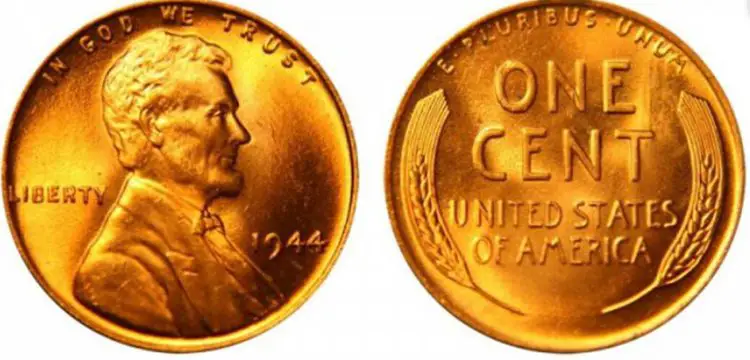
This copper penny is actually a member of the Lincoln wheat cent—the copper one-cent coin with the bust of Abraham Lincoln on the obverse and the wheat stalks on the reverse.
The wheat coins are altogether a large family of pennies with an interesting backstory that began in 1909 when they began to be struck by the US mint.
History
The wheat penny is the longest-running United States coin that you can find in circulation. The penny began production in 1792 but the one in 1909 was the first coin to feature the face of a president which makes it quite a special penny series.
It was President Roosevelt’s administration that commissioned the production of the Lincoln penny to celebrate the 100th anniversary of Abraham Lincoln’s birthday.
The 1944 copper penny was one of the wartime cents. The war caused a shortage in that year
so the mints used only copper and tin without zinc in the manufacture of cents. This was an upgrade on the previous year’s production when the mints had no copper at all for production and used steel coated with zinc instead.
People complained that the 1943 pennies corrode easily. When the 1944 penny arrived, it became the most produced penny in the history of minting. In that year, steel pennies were produced too but it was by mistake.
These 1944 steel pennies have turned out to be some of the most valuable coins in history. It happened that steel blanks were left over from the 1943 production and these were used to strike some of the 1944 coins. Steel pennies deteriorated faster than copper hence a well-preserved steel penny is usually very valuable.
This penny in question features the designs by Victor David Brenner who was responsible for the original in 1909. The 1944 wheat penny features the bust of Abraham Lincoln on the obverse and the wheat stalks on the reverse.
They also feature different mint marks too. Overall, more than 2 billion wheat pennies were struck in the three mints—Philadelphia, Denver, and San Francisco. And all were made from 95% copper and 5% zinc. Some of these metals were from wartime shells and ammunition in world war two.
| 1944 Penny | |
| 1944 | 1,435,400,000 |
| 1944 D | 430,578,000 |
| 1944 S | 282,760,000 |
| Total | 2,148,338,000 |
Consequently there exist 1944 copper pennies with the D/S mark on them. They are some of the most valuable pennies sought after by collectors. The most worn D/S coin is worth more than $100. The 1944 copper pennies were called so because, in that year, the treasury resumed making coins using 95% more copper instead of steel which was used the previous years. The coin would resume being called wheat pennies after this.
| 1944 Copper Penny Composition | |
| Value | 1 Cent ($0.01) |
| Mass | 3.11 gram |
| Diameter | 19.05 mm |
| Edge | Plain |
| Composition | 95% Copper, 5% Zinc |
| Year of minting | 1944 |
| Designer | Victor David Brenner |
Some in the polity have called for the discontinuation of the Lincoln penny because of the decline in its buying power. The penny has become more expensive to make these days. For example, one cent now costs the US around 1.4 cents to make each piece. In 2002, a representative from Arizona by the name of Jim Kolbe moved a motion to have the penny eliminated but the bill failed.
There have been more attempts to have the pennies pushed out of circulation. These attempts unfortunately have the backing of federal laws, although unwittingly so. Federal laws say coins are legal tender but it doesn’t compel anyone to accept them.
For this reason in 2007 a Chinese restaurant in New York City refused to accept pennies from a customer as payment for dinner. The government continues to keep the penny because of sales tax. Without them, you can’t get change when you make purchases.
Design
This is Abraham Lincoln’s penny. It was designed with his head on it to celebrate the great icon. It features the same design from 1909.
Obverse
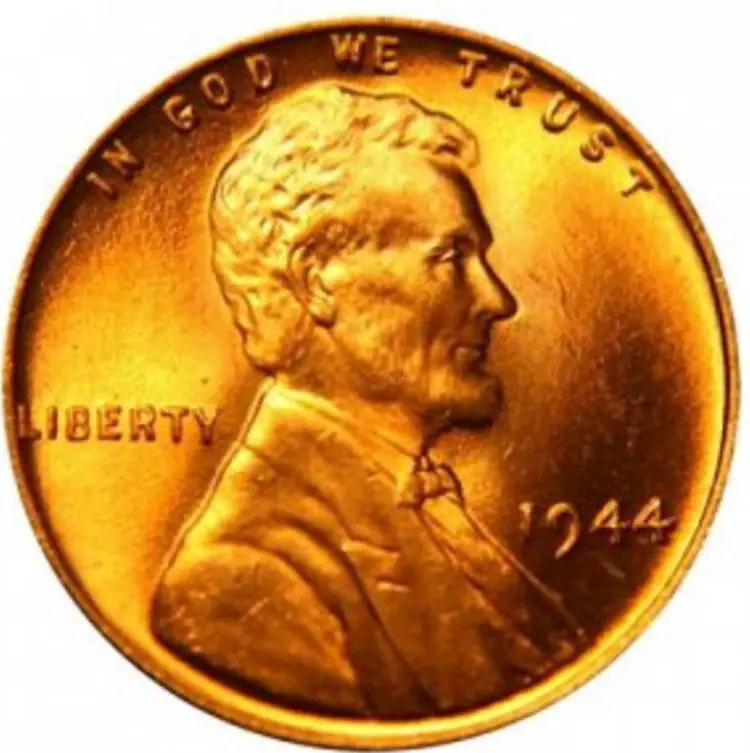
In the picture above you see the detailed profile of Abraham Lincoln, a very recognizable design by Victor David Brenner. The words IN GOD WE TRUST border the coin over the former president’s head.
The date the coin was made is engraved on the right, in front of the image 1944. Behind him is the word LIBERTY. The In God We Trust on the coin was first used on a two-cent piece in 1864. The Coinage Act of 1864 allowed the secretary of the Treasury to authorize the inclusion of the words on one-cent and two-cent coins.
Reverse
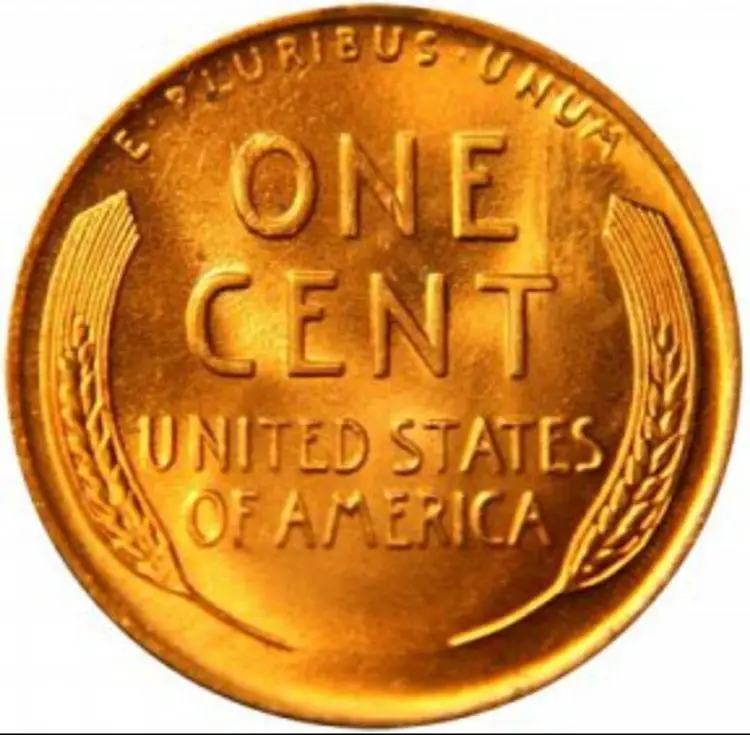
There are two inscriptions on the other side of the copper penny. The first and most prominent on the reverse is ONE CENT, followed by the UNITED STATES OF AMERICA. Hemmed into the edge of the coin is the US motto: E PLURIBUS UNUM. On both sides of the coin are two wheat stalks.
Mints
Three main manufacturing factories are responsible for producing the US coins. They are each located in Philadelphia, Denver, and San Francisco. You can often tell which copper penny is out of which mint by the presence, or a lack of a mint mark.
Philadelphia Mint
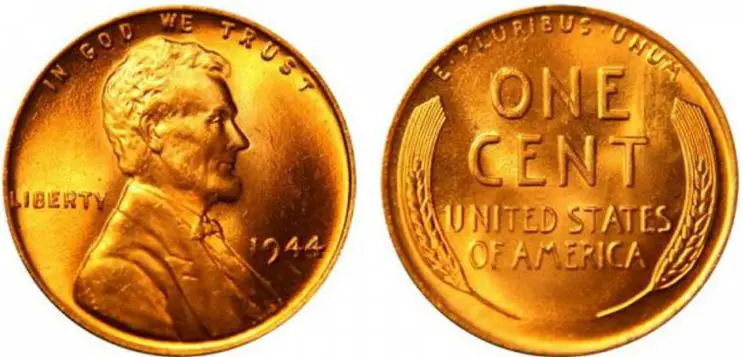
The United States facility in Philadelphia is located in a neighborhood in the City center east. It is a 4-minute walk from Franklin Square. It was the first by Congress in 1792. In 1944 this facility minted 1,435,400,000 copper pennies. They all came off the presses with no mint mark which is the tradition with this facility. The pennies all incorporated the metal composition of 95% copper and 5% zinc.
Denver Mint
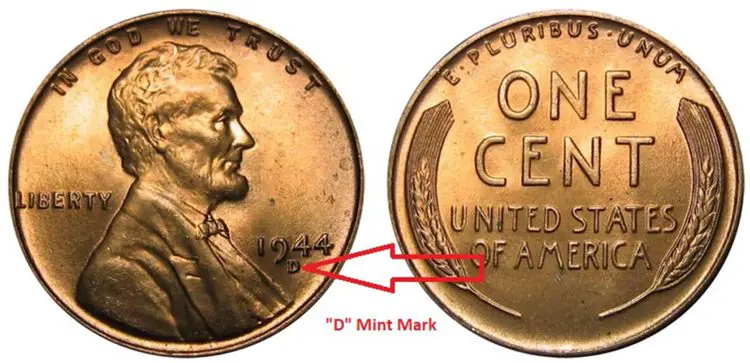
The facility is located at West Colfax Avenue in Denver, Colorado not far from the Gold Dome of the State Capitol. This facility is a very important one for the production of US coins. It is responsible for making billions of coins every year. In 1944 the facility produced 430,578,000 copper pennies for circulation following the standard composition of copper and zinc for Lincoln pennies. All copper pennies from this mint have the D mark below the 1944 date on the obverse of the coin.
San Francisco Mint
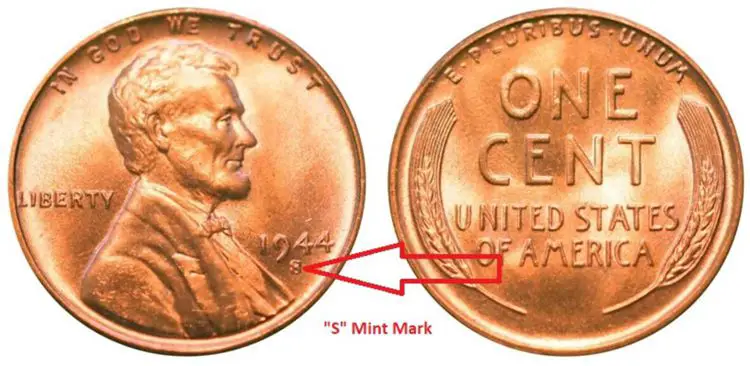
This mint was opened in 1854 in the era of the gold rush to serve California mines. In 1937 operations moved to a new building in Hermann and Buchanan street where it continues to be till now. In 1944 the mint produced 282,760,000 pennies bearing the S mark under the 1944 date on the obverse.
As you shall see, these are the major pennies and the facilities where they were produced. Moreover, there are other 1944 copper penny variations that are equally important to mention, that were produced in these facilities. Each of the various copper pennies has its own value.
Grading The 1944 Copper Penny
First, here’s brief information about how coins are graded and values assigned. Pennies or any coin are graded by using two types of systems. The PR system is used to grade Proof coins—those produced and sold to collectors and not for public spending—are graded from 1 to 70. The higher the number the better the condition of the coin.
Regular circulated and uncirculated coins are graded using the system called MS which means Mint State. The system begins from 60 to 70 for grading uncirculated coins. The higher the grade the better the condition of the coin.
Regular circulated coins are graded from 1 to 59. A coin that is graded 1 is in poor condition and one graded 59 is about uncirculated, that is, it is close to a mint state coin.
Mint State coins are graded by how much appeal they have to the eyes. Magnifiers are also used to ascertain the condition. Professional graders want to check your penny for luster, color toning, hairlines, and scratch marks to judge where the coin falls on the grading table. \
Uncirculated: Uncirculated coins were never used in commerce. From the moment they were minted and put into circulation, their owners kept them safe in a bank vault. As a result, these coins will show absolutely no damage and will appear just as they did when they were first minted. Of course, some color on the coin’s faces will have faded over time.
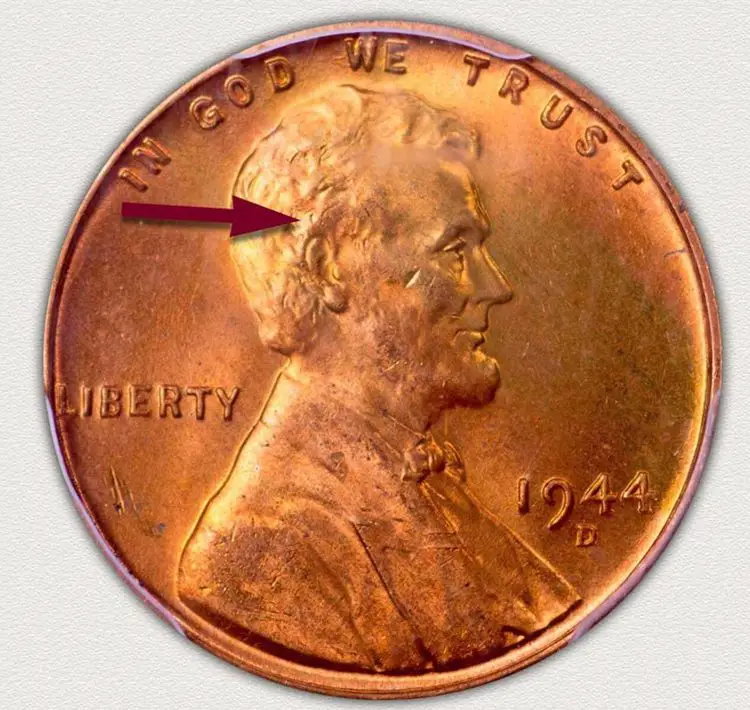
When you examine a 1944 Lincoln cent, you may notice that it still has mint luster on its surface. You can also be sure that the penny didn’t go into circulation when you see all the details, including the collar lines of Lincoln’s coat, which should be sharp, and his shirt lapel, which is clearly defined.
Extremely Fine: An Extremely Fine (EF) coin has minor imperfections, but is still mostly in perfect condition. A coin with a few slight imperfections will generally fall into this category. The imperfections are usually small enough that they are difficult to see with the naked eye and only affect the coin’s value slightly.
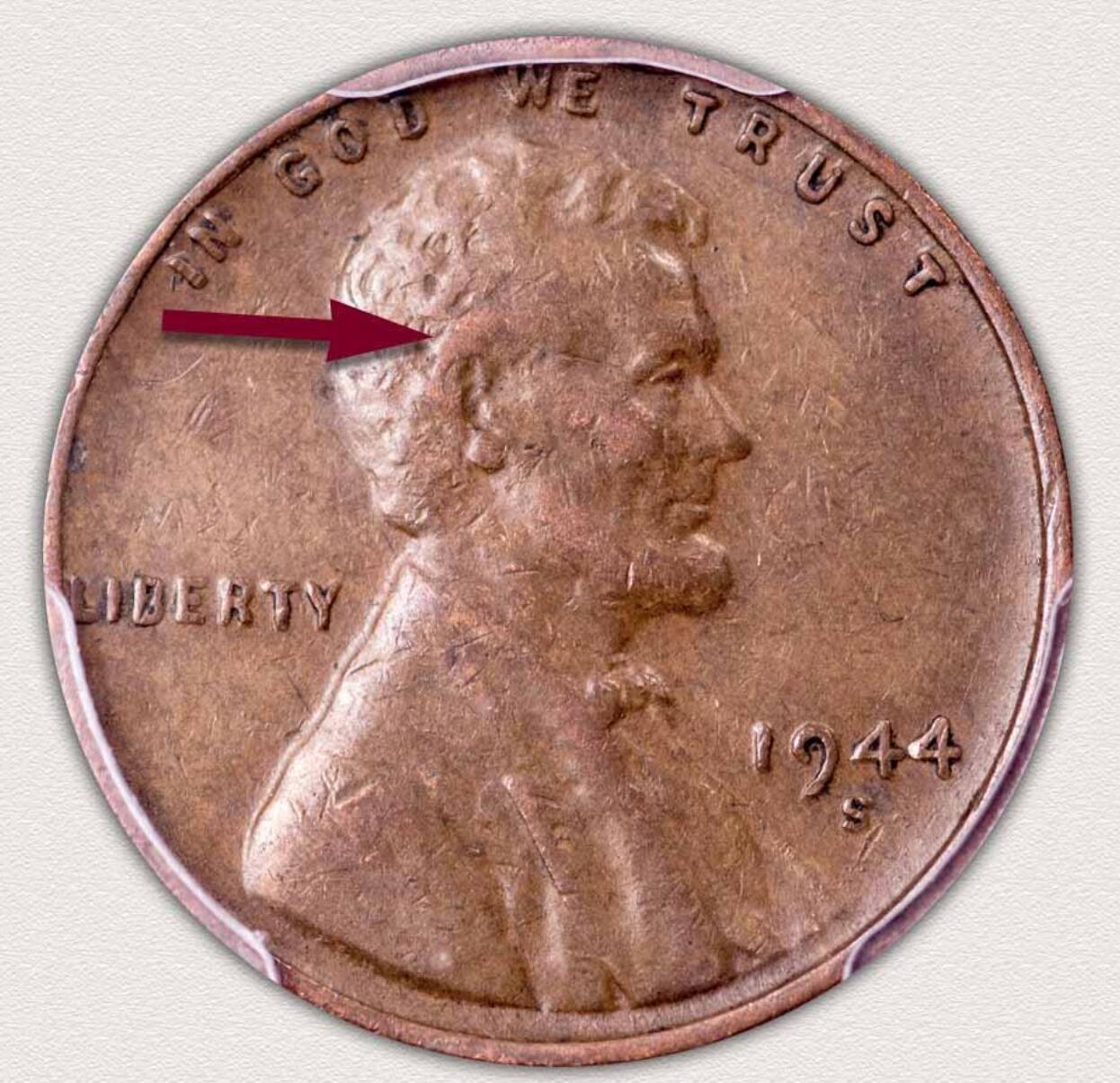
Fine: A coin-graded Fine has been in circulation for at least 10 years, but less than 25. For the 1944 Lincoln, you might notice some smoothing of the outer edges and some scratches. In most cases, this damage is typical for a circulated coin from this era.
Good: Good-graded coins have been circulated for most of their lives, and they will show heavy damage to the point where some raised inscriptions and imagery might be worn away. Rare, collectible coins like these are still sought by collectors despite their severe wear.
1944 Copper Penny, Varieties And Their Value
Now let’s consider the value of the 1944 Copper cent and all its varieties. This includes all the 1944 Copper cent error coins there are. Each consideration will come with a table outline of the prices.
1944 Copper Penny Value

The 1944 Lincoln wheat penny is estimated to be worth $0.05 in average condition and can be worth $1.13 to $5.70 or more in uncirculated (MS+) mint condition.
This is the first year in which the United States Mint has struck over a billion coins for any one coin series. Just four other Wheat Lincoln cents—issued in 1944, 1945, 1956, and 1957—have mintages exceeding a billion struck coins.
The 1944 Copper Penny has an affinity for a higher value. It’s on record that it’s been sold for a whopping $22,000 at auction. More than one billion of this penny were produced in that year of 1944. But even this high mintage hasn’t diminished the value that a penny in great condition can have. To put things in better perspective see this chart below for prices.
Quality |
Price |
MS 65 |
|
MS 66 |
|
MS 66+ |
|
MS 67 |
|
MS 67+ |
|
MS 68 |
1944 D Copper Penny Value
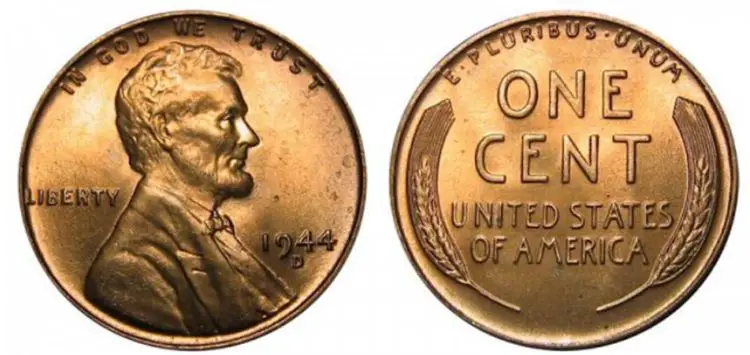
The 1944-D Lincoln wheat penny is estimated to be worth $0.05 in average condition and can be worth $0.96 to $4.52 or more in uncirculated (MS+) mint condition.
The 1944-D Lincoln cent is a common coin in all circulated grades, and Mint State specimens are available in MS66 as well. It is scarce in MS67, and better specimens are rare. The strike and color on this issue is generally excellent, with many pieces exhibiting blazing luster.
The 1944 D copper has been known to sell for a premium at a good grade too. More than 430 million of these pennies were struck in 1944 and quite a number of the copper pennies still turn up in mint state. Depending on how high your copper penny is graded, you sure can make a good sale off it. Consider the chart below for live sales of the copper marked D.
Quality |
Price |
MS 65 |
|
MS 66 |
|
MS 67 |
|
MS 67+ |
|
MS 68 |
1944 S Copper Penny Value
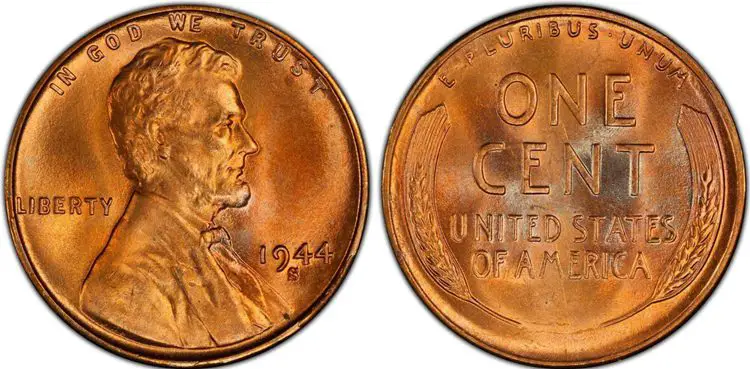
The 1944-S Lincoln Wheat Penny is estimated to be worth $0.11 in average condition and can be worth $0.96 to $4.52 or more in uncirculated (MS+) mint condition.
In circulated condition, the 1944-S Lincoln cent is extremely common and available in plentiful numbers up through the grade of MS66. In MS67, 1944-S pennies are scarce and in higher grades this issue is considered scarce.
Many high-grade Gem coins exhibit great luster and rich color, plus a strong strike. This means there are many of these coins to satisfy the market’s demand.
The copper penny minted in San Francisco has an S mark under 1944 and more than 200 million of them were produced. The penny with the S mark doesn’t do as much in the value department as the other two types as the chart below indicates.
Quality |
Price |
VF 35 |
|
XF 40 |
|
AU 55 |
|
AU 58 |
Error Coins
1944 D Over S Copper Penny Value
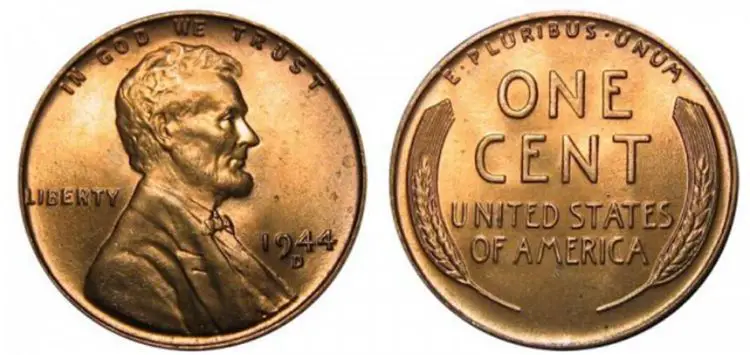
This is a variety of the 1944 D penny. As you can see in the picture above, you can make out the tip of the S at the top of the D. The D mark is more obvious making it a D penny. This error coin can be found in the mass of coins made in the Denver mint. If you have a collection of D copper coins from 1944 you should take a quick look at them. They sell for a premium sometimes too as indicated by the chart below.
Quality |
Price |
XF 40 |
|
MS 45 |
|
MS 50 |
|
AU 53 |
|
AU 55 |
|
AU 58 |
|
MS 61 |
|
MS 62 |
|
MS 63 |
|
MS 64 |
1944 Steel Cent Value
This steel cent was produced in the Philadelphia mint and it came about when the new cent was struck using steel blanks left over from the 1943 mintage when copper was scarce for production. Zinc is coated with steel for this coin and it comes with the same design as the copper coins. There are about 30 of these cents in circulation. They are worth a premium in mint condition.
Quality |
Price |
AU 50 |
|
AU 53 |
|
AU 55 |
|
MS 61 |
|
MS 62 |
|
MS 63 |
|
MS 64 |
1944 D Steel Cent Value
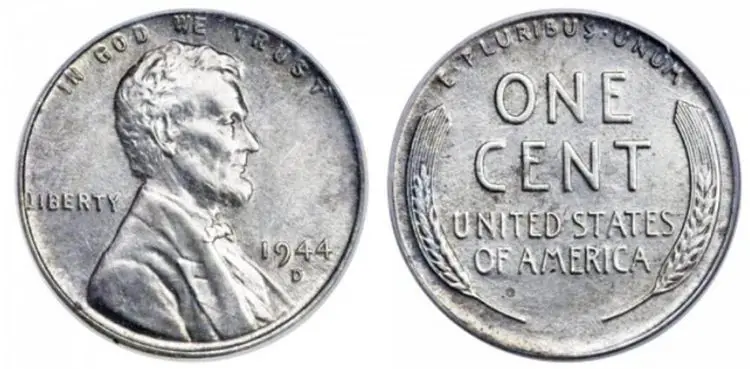
Like the preceding coin, this steel cent which was produced in the Denver mint is zinc coated with steel. This cent was produced when they used zinc coated steel planchet left over from 1943. Only 7 of these cents are known to exist although experts are of the opinion that there could be more out there somewhere. This steel cent can sell for premium prices.
Quality |
Price |
AU 53 |
|
AU 58 |
|
MS 62 |
|
MS 63 |
1944 S Steel Cent Value
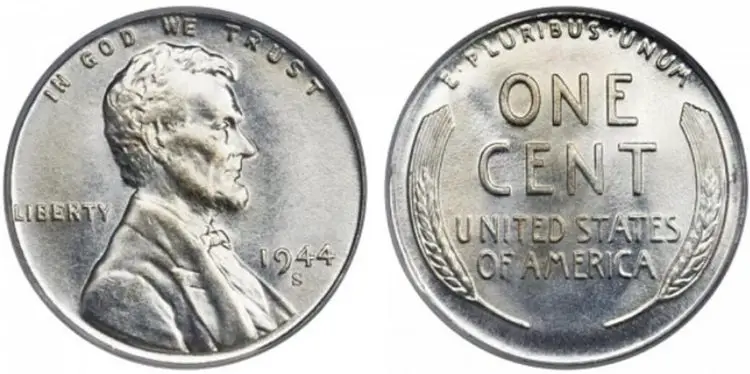
This is the S version of the steel cent which was produced by the San Francisco mint. It happened for the same reason as the one in the Denver facility. Only two of these steel 1944 cents are known to exist. And it comes in very premium prices. A 1944 steel-cent-graded MS 63 is worth more than a million dollars.
Quality |
Price |
XF 40 |
|
MS 66 |
5 Most Valuable 1944 Copper Penny Ever Sold
| 5 Most Valuable 1944 Copper Penny | ||||
| No. | Type | Condition | Sold Date | Price |
| 1 | 1944-S 1C Struck on a Zinc-Coated Steel Planchet | MS66 | Aug 18, 2021 | $408,000.00 |
| 2 | 1944-S 1C –On a Zinc-Plated Steel Planchet | MS66 | Jul 31, 2008 | $373,750.00 |
| 3 | 1944 1C Struck on a Zinc-Coated Steel Planchet | MS64 | Jun 17, 2021 | $180,000.00 |
| 4 | 1944-D 1C –Struck on a Zinc-Coated Steel Planchet | MS63 | Aug 9, 2007 | $115,000.00 |
| 5 | 1944 1C Struck on a Zinc-Coated Steel Planchet | MS66 | Aug 18, 2021 | $108,000.00 |
1. 1944-S 1C Struck on a Zinc-Coated Steel Planchet MS66 Sold on Aug 18, 2021 for: $408,000.00
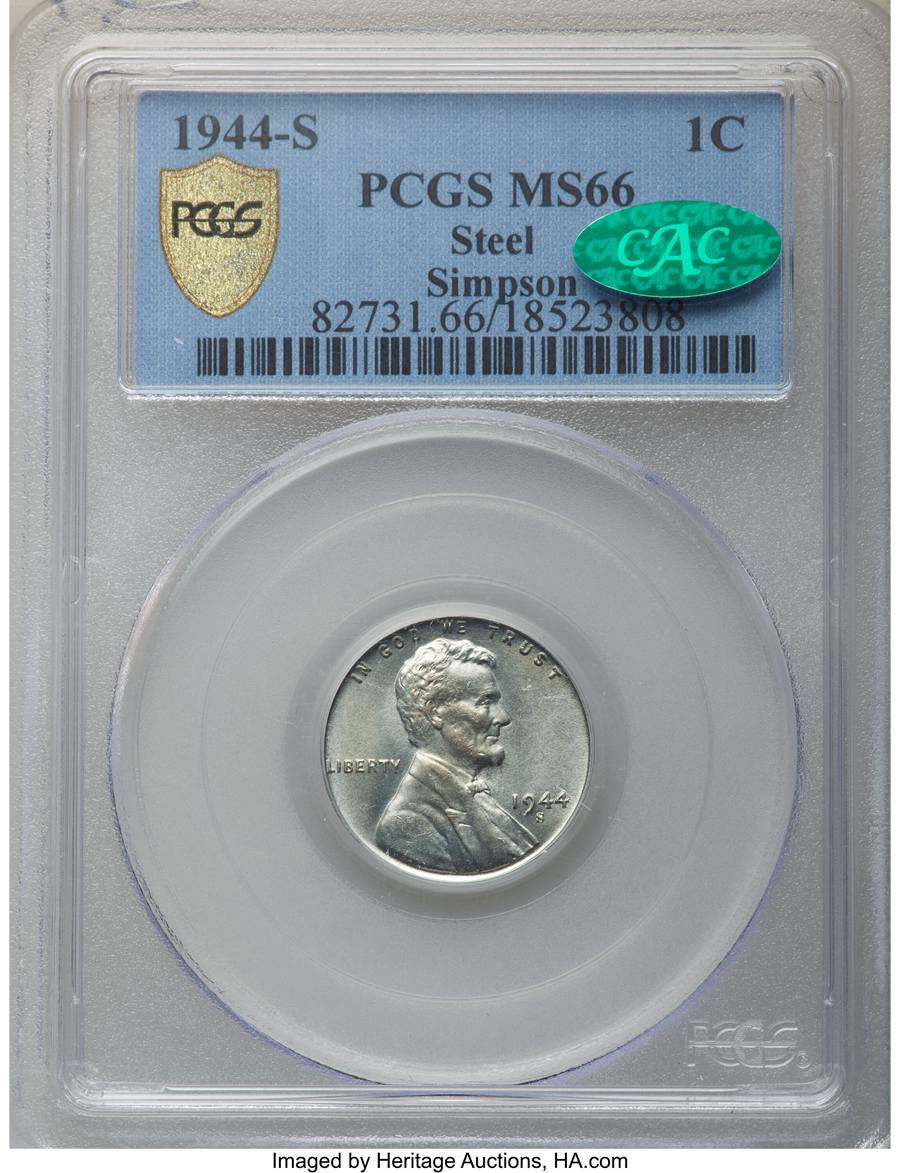
2. 1944-S 1C –On a Zinc-Plated Steel Planchet–MS66 Sold on Jul 31, 2008 for: $373,750.00
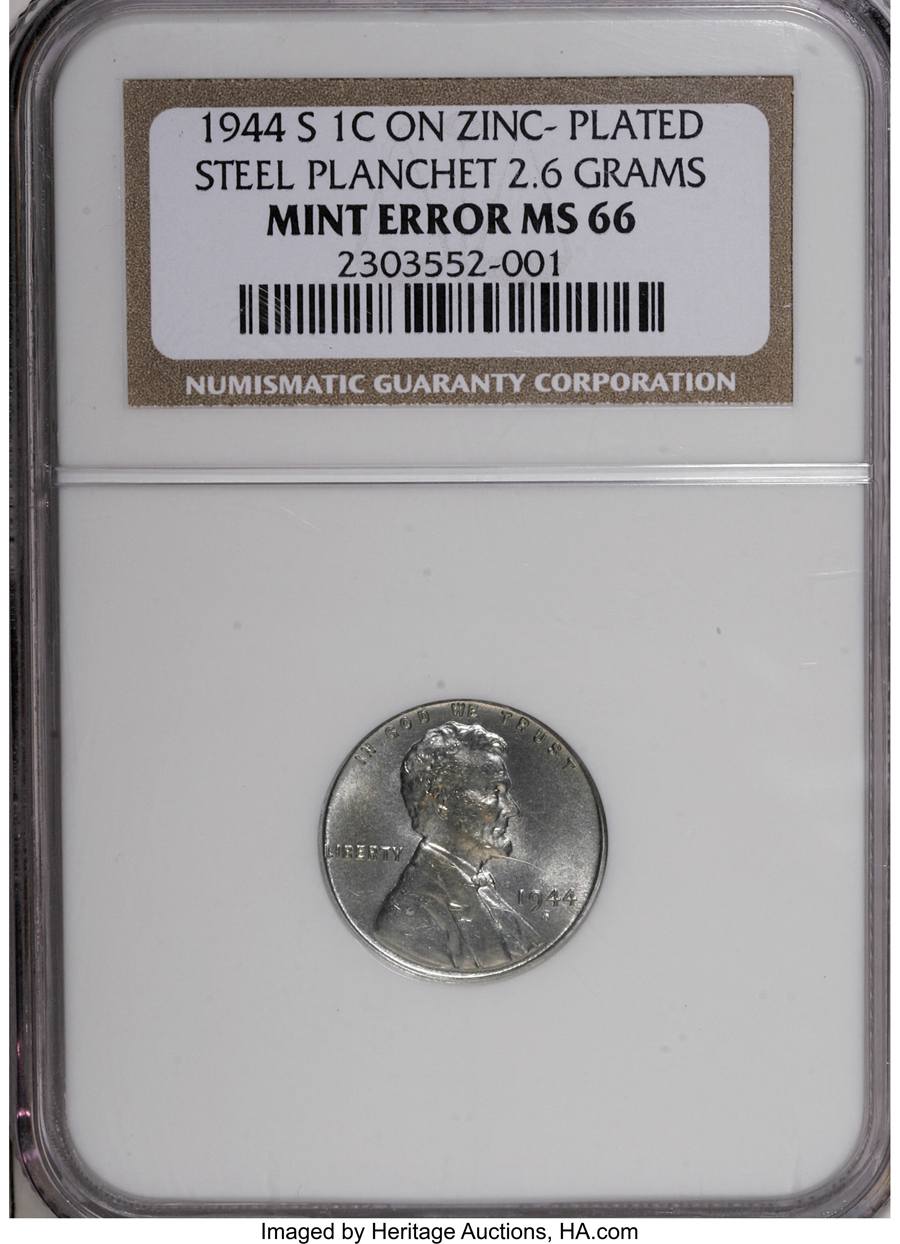
3. 1944 1C Struck on a Zinc-Coated Steel Planchet MS64 Sold on Jun 17, 2021 for: $180,000.00
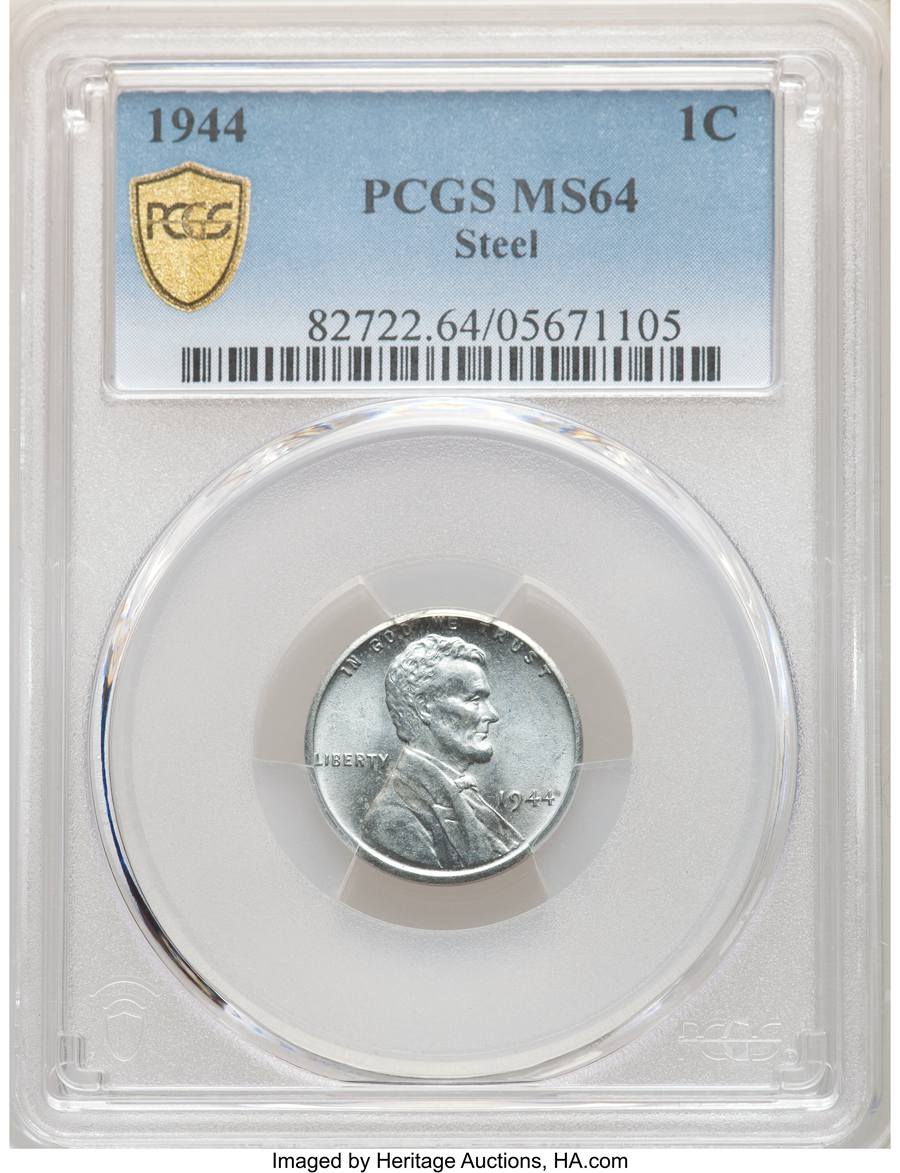
4. 1944-D 1C –Struck on a Zinc-Coated Steel Planchet–MS63 Sold on Aug 9, 2007 for: $115,000.00
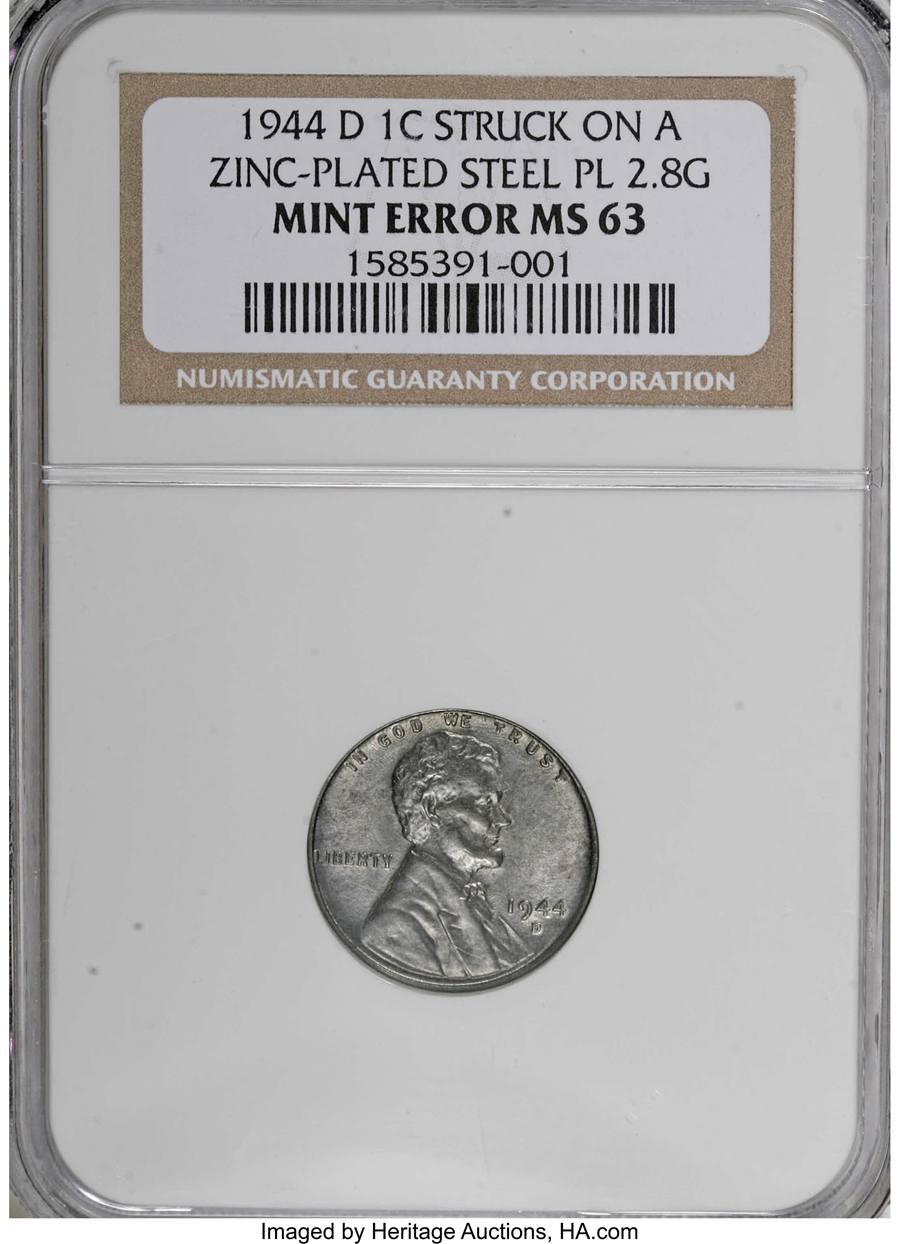
5. 1944 1C Struck on a Zinc-Coated Steel Planchet MS64 Sold on Aug 18, 2021 for: $108,000.00
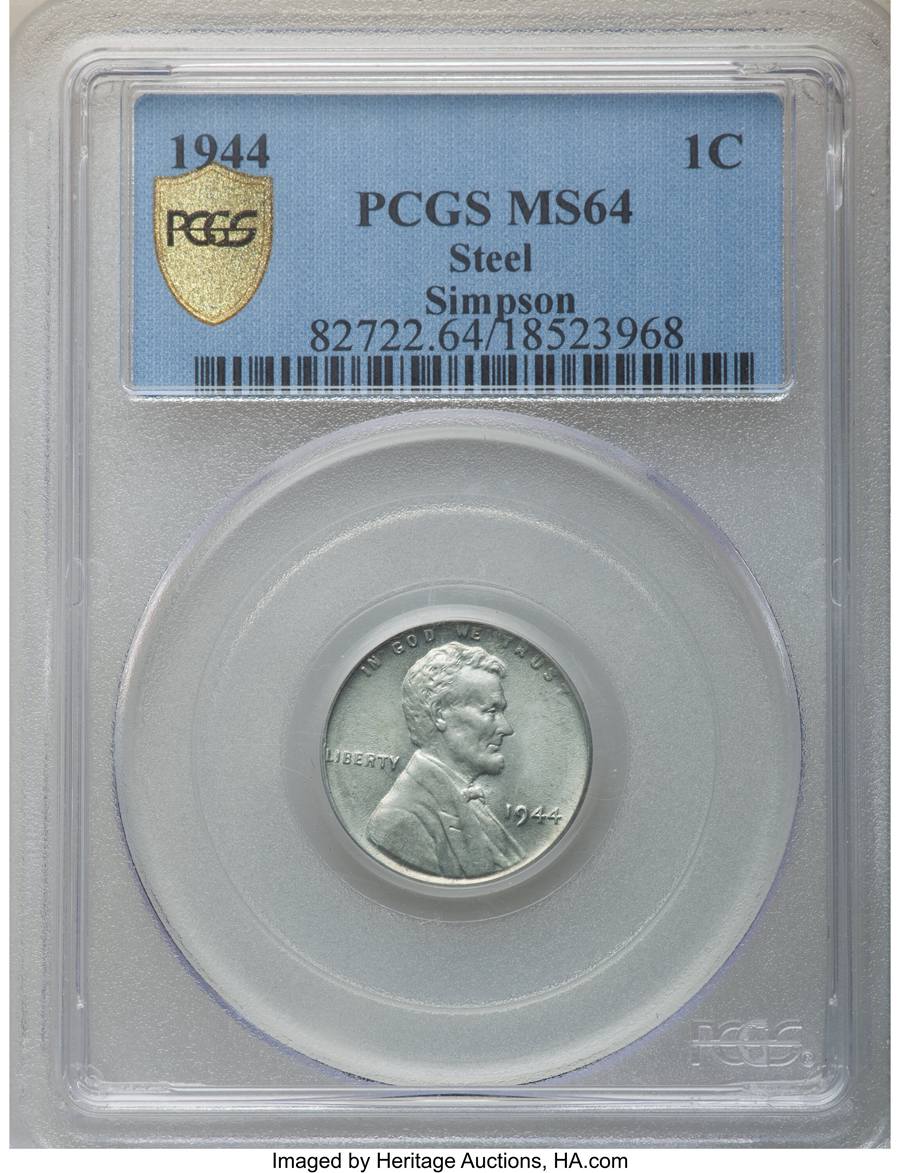
Where To Sell Your 1944 Copper Cents
Suppose you have one of these pennies from 1944, what then? Well, there are a number of options open to you. You can keep the pennies in your collection for the purpose of exhibiting them to your friends and visitors. Or you can choose to sell them. There are several places where you can sell your 1944 Copper Cents. The best of them are;
eBay
One of the most popular places to sell your coins is eBay. All that is required of you is to post real images of the copper cents and pay a certain percentage of the sales to the website. For more information on how to register, head to the eBay website. Your coins are exposed to a wide majority of the audience.
Etsy
This website is much like eBay too. You pay a fee that is deducted when you make your sale. Hundreds of people visit this website daily searching for antiques. Your coin will be available to hundreds of visitors to the website.
Online Auction Websites
This is highly recommended because here’s where most collectors and coin dealers are here to bid for rare coins. It will be a plus for your coin if it is graded too. A quick Google search will throw up auction sites like Heritage Auctions, and PCGS.
Bottom Line
You have just become acquainted with one of the most versatile coins in US history. The intrigue with the varieties of the 1944 Copper cent makes it even more appealing. Now you know how to identify this one-cent coin. If it turns up in your collection of coins in the attic, get it graded. It just might fetch you a premium at sale.

Sharon Fox
Sunday 21st of January 2024
I have a 1934 wheat penny how much is it worth
Anglo
Thursday 29th of June 2023
I have one cent 1944 and another one cent 1944 mint makes d
Greg Powell
Saturday 13th of May 2023
i have a 1944 zinc penny that has a thin copper veneering over it the L is missing in liberty it has many mistakes on it.and although it looks kind of rough its not .appears all roughness is product of the strike or dye